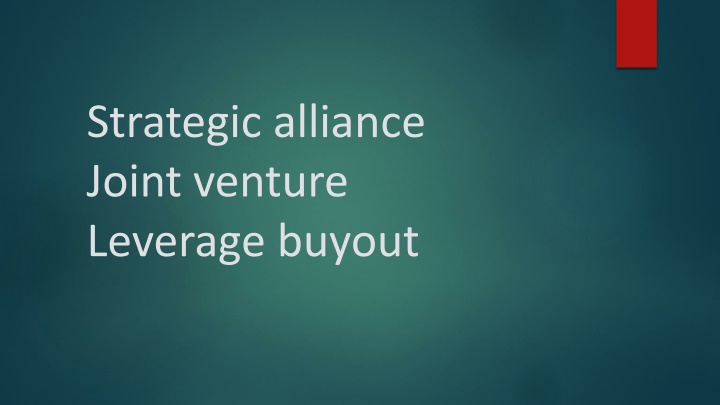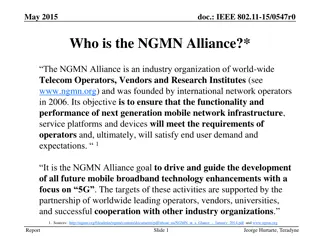
Strategic Alliances, Joint Ventures, and Leveraged Buyouts
Explore strategic alliances, joint ventures, and leverage buyouts as valuable business strategies for mutual benefit, market expansion, and resource optimization. Learn about the types of alliances, how they create value, and why companies form joint ventures to leverage resources and expertise.
Download Presentation

Please find below an Image/Link to download the presentation.
The content on the website is provided AS IS for your information and personal use only. It may not be sold, licensed, or shared on other websites without obtaining consent from the author. If you encounter any issues during the download, it is possible that the publisher has removed the file from their server.
You are allowed to download the files provided on this website for personal or commercial use, subject to the condition that they are used lawfully. All files are the property of their respective owners.
The content on the website is provided AS IS for your information and personal use only. It may not be sold, licensed, or shared on other websites without obtaining consent from the author.
E N D
Presentation Transcript
Strategic alliance Joint venture Leverage buyout
S Strategic Alliance
Strategic Alliance A strategic alliance is an arrangement between two companies to undertake a mutually beneficial project while each retains its independence. A company may enter into a strategic alliance to expand into a new market, improve its product line, or develop an edge over a competitor. The arrangement allows two businesses to work toward a common goal that will benefit both. The relationship may be short-term or long-term. Strategic alliances diversify revenue streams, grant access to potentially difficult-to-obtain resources, and may improve a company's public image. Strategic alliances may also cause companies to expend resources resolving conflict, not yield results as expected, or negatively impact a company's public image.
Types Of Strategic Alliance Equity Strategic Alliance : An equity strategic alliance may have similar outcome goals as a joint venture; however, it is funded differently in that one company makes an equity investment into another. Non-Equity Strategic Alliance: A non-equity strategic alliance forms when two entities realize mutual benefit exists and no equity transfusion is necessary. A more simple contractual obligation is agreed upon for the two entities to pool resources and capabilities together.
How Do Strategic Alliances Create Value? Improving short-term finances. Eliminating barriers to entry. Gaining better business insights. Sharing financial risk. Innovating beyond current capabilities.
Joint Venture (JV) A joint venture (JV) is a business arrangement in which two or more parties agree to pool their resources for the purpose of accomplishing a specific task. This task can be a new project or any other business activity. Each of the participants in a JV is responsible for profits, losses, and costs associated with it. However, the venture is its own entity, separate from the participants other business interests. They are a partnership in the colloquial sense of the word but can take on any legal structure. A common use of JVs is to partner up with a local business to enter a foreign market.
Why companies form JV To Leverage Resources To Reduce Costs To Combine Expertise To Enter Foreign Markets
Examples of Joint Venture Companies Tata Starbucks Bharti-AXA General Insurance Co Ltd Mahindra-Renault Ltd AirAsia India Bayer Zydus Pharma JV with Cadila Healthcare
Leveraged Buyout A leveraged buyout (LBO) is the acquisition of another company using a significant amount of borrowed money (bonds or loans) to meet the cost of acquisition. The assets of the company being acquired are often used as collateral for the loans, along with the assets of the acquiring company. A leveraged buyout (LBO) occurs when the acquisition of another company is completed almost entirely with borrowed funds. Leveraged buyouts declined in popularity after the 2008 financial crisis, but they are once again on the rise. In an LBO, there is usually a ratio of 90% debt to 10% equity.
Characteristics of a LBO Candidate Strong, predictable operating cash flows with which the leveraged company can service and pay down acquisition debt Mature, steady (non-cyclical), and perhaps even boring Well-established business and products and leading industry position Moderate Capex and product development (R&D) requirements so that cash flows are not diverted from the principle goal of debt repayment Limited working capital requirements Strong tangible asset coverage Undervalued or out-of-favor






















